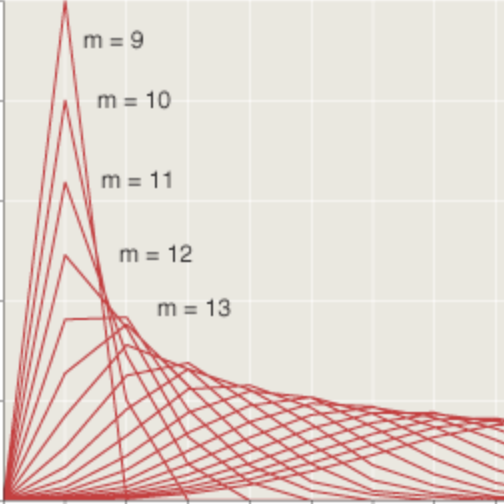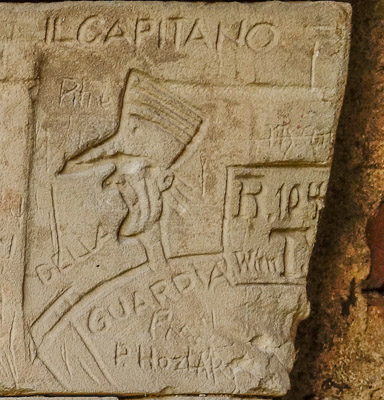Who was Aleph Null?
by Brian Hayes
Published 2 September 2013
Thirty years ago this month Scientific American launched a new column called “Computer Recreations.” I wrote the first six installments, then passed the baton to A. K. Dewdney.
Soon after the first column appeared, we received a letter pointing out that the title “Computer Recreations” had already been used by the journal Software—Practice and Experience. I was embarrassed by this revelation, not because of any worries about legal conflicts but because I should have known what other publications were doing in the same genre. I went off to the library to look at some back issues of SP&E. Here’s what I found in Vol. 1, No. 1, published a dozen years earlier, in 1971:

Through the rest of 1971 and into 1972 there were half a dozen more “Computer Recreations” columns attributed to \(\aleph_0\!\), followed by a couple of guest columns (the first by Paul Bratley and Jean Millo of the University of Montreal, the second by Andrew Tanenbaum of the Vrije Universiteit in Amsterdam). After that, “Computer Recreations” disappeared from the pages of Software—Practice and Experience, never to be mentioned again.
Recently I had occasion to take a fresh look at the SP&E columns, and I realized that I have never learned the true identity of the mysterious \(\aleph_0\!\). Maybe one of my readers can help unmask the author. Or maybe the real Aleph Null will step forward now to take credit for his or her work. I’m also curious about a figure called Archimedes, who appears in several of the columns as a mentor or sidekick of \(\aleph_0\!\). In one column Archimedes is said to be “a group of mathematicians.”
For a while I thought that Aleph Null and Archimedes might have been members of the Bell Labs gang that was so lively and prolific in the late 60s and early 70s—Dennis Ritchie, Ken Thompson, Brian Kernighan, Doug McIlroy, Michael Lesk and others—the crew who gave us C and Unix and so much else. But that can’t be right. One of the SP&E columns discusses Darwin, a game in which programs compete for space and survival in a computer’s memory. (Dewdney later wrote about a similar system called Core War.) Darwin was invented at Bell Labs, but the SP&E column describes the program from an outsider’s perspective: \(\aleph_0\!\) and Archimedes talk to the Bell Labs group and then build their own implementation of the system.
 In addition to seven “Computer Recreations” columns, \(\aleph_0\!\) is also listed as the author of a 1973 book review in SP&E. The book under review is Games Playing with Computers, by A. G. Bell. For a few days this summer I entertained the notion that \(\aleph_0\!\) = A. G. Bell. The review of Bell’s book is rather harsh, but that didn’t dissuade me; after all, every author is his own worst critic. A glance at the book would surely settle the matter, I thought, but none of the libraries within easy reach of Boston could supply a copy. Eventually I bought one online (for $3.44, plus shipping). I’m afraid I found no support for my cute self-reviewing hypothesis. Stylistically, Aleph Null and A. G. Bell have nothing in common.
In addition to seven “Computer Recreations” columns, \(\aleph_0\!\) is also listed as the author of a 1973 book review in SP&E. The book under review is Games Playing with Computers, by A. G. Bell. For a few days this summer I entertained the notion that \(\aleph_0\!\) = A. G. Bell. The review of Bell’s book is rather harsh, but that didn’t dissuade me; after all, every author is his own worst critic. A glance at the book would surely settle the matter, I thought, but none of the libraries within easy reach of Boston could supply a copy. Eventually I bought one online (for $3.44, plus shipping). I’m afraid I found no support for my cute self-reviewing hypothesis. Stylistically, Aleph Null and A. G. Bell have nothing in common.
Software—Practice and Experience is a publication with British roots. The first editors were C. W. Barron of the University of Southampton and C. A. Lang of Cambridge. The journal’s Cambridge connections were particularly strong in those early days, with a board of editors that included Maurice V. Wilkes, who had headed the Cambridge Computer Laboratory since 1945. I now incline to the view that Aleph Null and Archimedes were part of this milieu—almost surely from Britain and probably from Cambridge. But I have made no further progress in identifying them.
If you would like to join in the guessing game, here are a few clues to consider, culled from the seven published \(\aleph_0\!\) columns:
- In the first column Aleph Null writes of himself or herself: “I confess to a personal interest in artificial intelligence.”
- In another column the author mentions “visiting the northern parts of the British Isles,” from which I infer that Aleph Null is not native to those northern parts.
- Archimedes is described in one column as “myopic” and in another as “cryptomnesiac.” Who knows what that’s about?
- There’s a PDP-7 in the picture. Archimedes seems to be adept at hacking on it. (This was a factor in my initial guess about Bell Labs, since the first version of Unix was created there on a PDP-7. But the Cambridge Computer Lab had one as well.)
- Most of the code in the columns is Fortran. There’s also some talk of BCPL (developed at Cambridge) and POP-2 (developed at Edinburgh). Plus lots of assembler. No hint of Algol.
Regrettably, the columns themselves are impounded behind a John Wiley paywall. Here are the topics:
1971 (1). The Military Game, or Napoleon.
1971 (2). MOO (also known as Bulls and Cows; similar to Master Mind).
1971 (3). The African board game kalah.
1971 (4). Space-filling curves with a plotter.
1972 (1). Darwin.
1972 (2). “April Foolery.” Puzzles on topics such as algorithms for card shuffling.
1972 (3). More curves with a plotter.
1972 (4). [By Bratley and Millo]. Self-reproducing programs.
1973 (4). [By Tanenbaum]. The game of JOTTO.
Update 2013-09-06: Commenter Shecky R has apparently solved the mystery. Using a nifty new technology called Google, he tracked down a bibliographic entry presented as follows:
Aleph Null (C. A. Lang). “Computer Recreations: Darwin.” Software: Practice and Experience v2, Jan-Mar 1972, p93-96.
Using another nifty technology called a library, I’ve looked at the book in which this entry appears (Analyzing Computer Security: A Threat/Vulnerability/Countermeasure Approach, by Charles P. Pfleeger and Shari Lawrence Pfleeger). There’s no hint in the book of how the Pfleegers know that Aleph Null = C. A. Lang, but I have no reason to doubt the identification.
With a little more sleuthing—it’s quite a marvel, this Google thing—I have learned that C. A. Lang is Charles Lang, who went on to a distinguished career in computer-aided design and three-dimensional modeling. From David E. Weisberg:
Charles Lang graduated from Cambridge University in 1960 with a degree in engineering. After several years at Mullard Research in England, Lang enrolled as a graduate student at MIT in 1963 and worked at Project MAC for more than 18 months with Doug Ross and Steven Coons. Lang was then recruited back to Cambridge University’s Computer laboratory by Professor Maurice Wilkes.
The British Government arranged funds and resources that underwrote the activities of the Cambridge CAD Group in 1965 — the group founded by Wilkes and headed by Lang until 1975. In 1969, the group started developing solid modeling software on a Digital PDP-7 system using assembly language programming. “Unfortunately no one told us it was impossible,” says Lang. “But then Ian Braid turned up.”
Now, what about this Archimedes bloke?
Update 2013-09-08: Shecky R solved the mystery and now Barry Cipra has unsolved it, with a 1971 document that includes the statement: “It should be noted that Aleph-Null and C. A. Lang are not the same person.”
Responses from readers:
Please note: The bit-player website is no longer equipped to accept and publish comments from readers, but the author is still eager to hear from you. Send comments, criticism, compliments, or corrections to brian@bit-player.org.
Publication history
First publication: 2 September 2013
Converted to Eleventy framework: 22 April 2025




“Cryptomnesiac” would presumably mean that one is susceptible to experiencing “the reappearance of a long-forgotten memory as if it were a new experience”.
(Alternatively, it means that one tends to remember code — an obvious interpretation in this context, but not one that is shared by any dictionary that I can find.)
Stan Kelly-Bootle?
well this seems too easy… I just typed “aleph null” and “computer recreations” into Google and got this link:
http://tinyurl.com/lz6g7nt
indicating that C.A. Lang (of Cambridge) was indeed your culprit.
Well, look at that! Thanks. I guess I’m going to have to learn how to use this Google thingie that I keep hearing about.
Googling on “aleph null c.a. lang” leads to a copy of a 1971 letter from M. Douglas McIlroy to “Aleph Null” (but sent to C.A. Lang) at http://www.cs.dartmouth.edu/~doug/darwin.pdf in which some explanatory texts notes that “Aleph-Null and C. A. Lang are not the same person.” Perhaps the Pfleegers simply adopted the convention of attributing anonymous or pseudonymous articles to the editor.
well, how bizarre! Could Comp. Recreations have been written by a “collective” of individuals, some by Lang, some by others? (akin to Nicolas Bourbaki), or could “Aleph Null” be an anagram of a real name (…I couldn’t come up with any candidates).
Surely, someone is still alive who knows the answer to the identity…
‘The Archimideans’ is the university-wide student mathematics society at the University of Cambridge (http://www.archim.org.uk/), which would fit with the “a group of mathematicians” comment.
I’m researching Core War history and I’d love to find out who Aleph Null was. I wonder if it’s worth tracking down Charles Lang and asking…
If you find him, please report back here! I’d love to hear about what you learn.
In case you haven’t yet found the answer to your question:
Aleph Null was an alias used by Richard Parkins.
I know this from personal experience - I met Richard many times at meetings of the Archimedeans when I was an undergraduate at Cambridge in 1968-1971. Remarks he attributes to Archimedes are generally based on discussions amongst members of the Archimedeans.
If you need further evidence, Richard himself admits it on his webpage here
I also have some interest in the game of MOO (a.k.a. Bulls and Cows).
I believe I was the first person to determine the optimal solution to MOO, over 16 years before Tanaka’s 1996 paper. I did not publish my findings, though, until 2010.
A copy of that 2010 paper can be found here
There was a company called Aleph One that produced peripherals for the Acorn Archimedes computer. There’s an interview with the founder where he mentions at some point that the company had been around since the 70s.
There’s at least one more (in)famous Aleph One. The author of the classic hacker text Smashing The Stack For Fun And Profit in Phrack 49.
Link: https://inst.eecs.berkeley.edu/~cs161/fa08/papers/stack_smashing.pdf